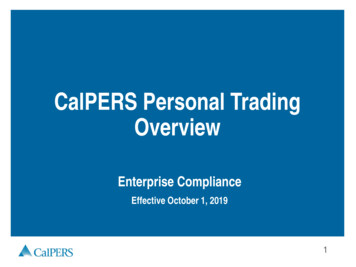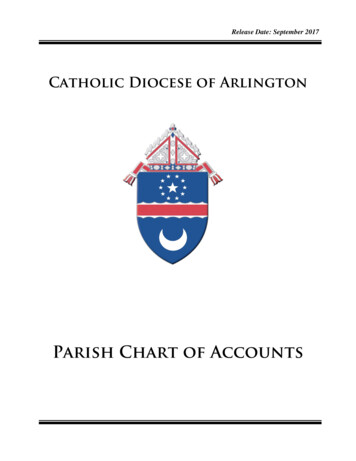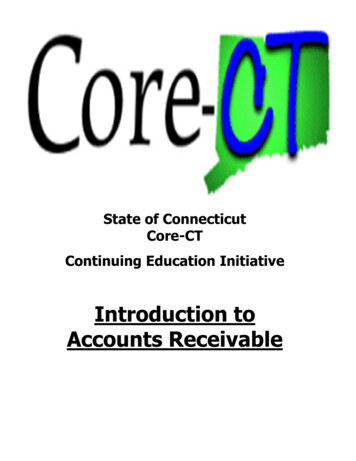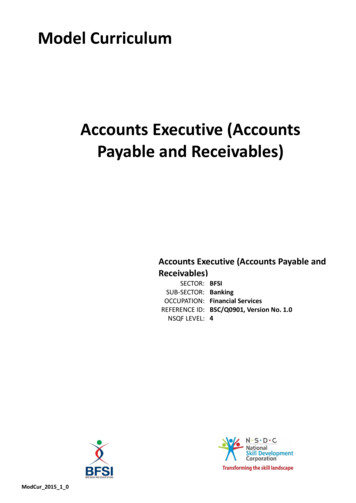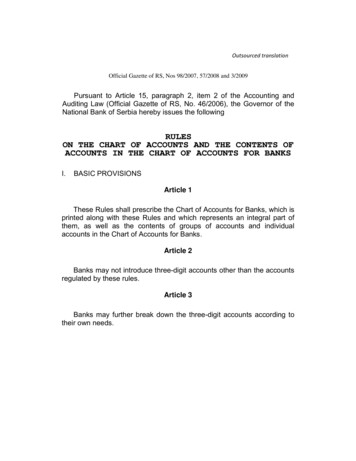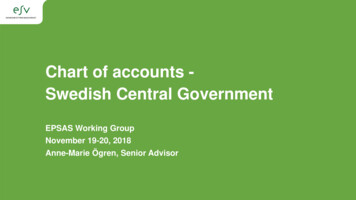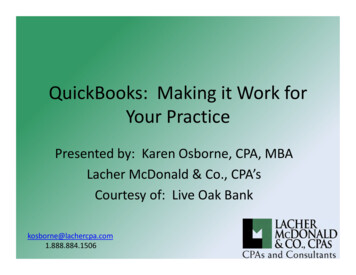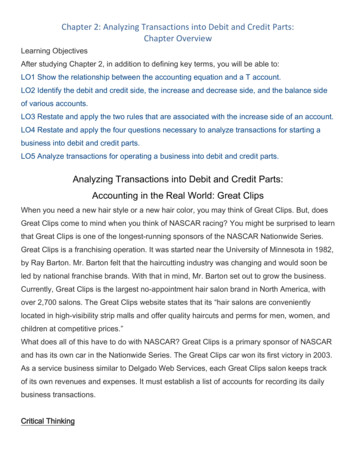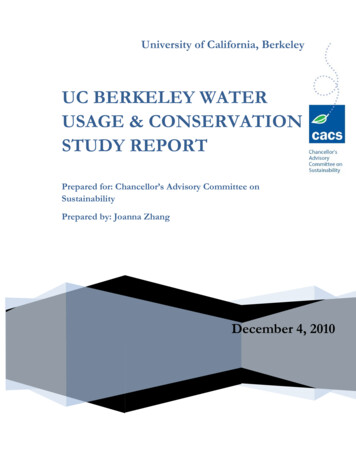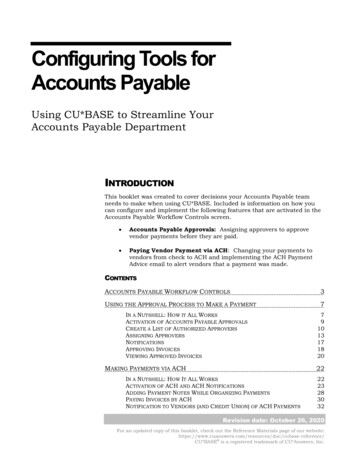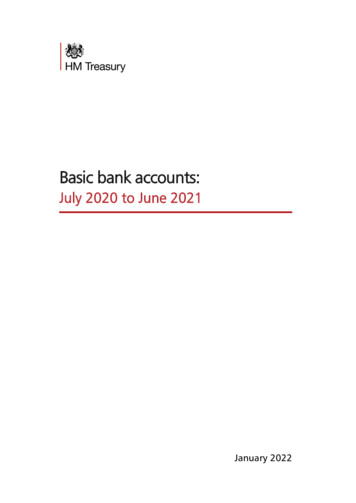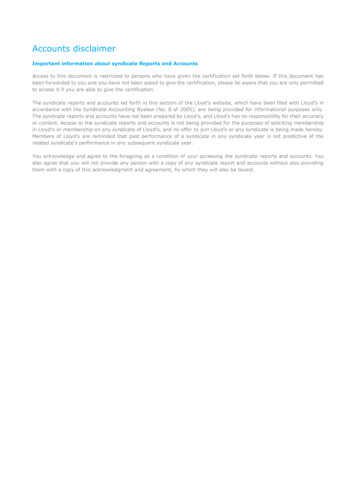
Transcription
Accounts disclaimerImportant information about syndicate Reports and AccountsAccess to this document is restricted to persons who have given the certification set forth below. If this document hasbeen forwarded to you and you have not been asked to give the certification, please be aware that you are only permittedto access it if you are able to give the certification.The syndicate reports and accounts set forth in this section of the Lloyd’s website, which have been filed with Lloyd’s inaccordance with the Syndicate Accounting Byelaw (No. 8 of 2005), are being provided for informational purposes only.The syndicate reports and accounts have not been prepared by Lloyd’s, and Lloyd’s has no responsibility for their accuracyor content. Access to the syndicate reports and accounts is not being provided for the purposes of soliciting membershipin Lloyd’s or membership on any syndicate of Lloyd’s, and no offer to join Lloyd’s or any syndicate is being made hereby.Members of Lloyd’s are reminded that past performance of a syndicate in any syndicate year is not predictive of therelated syndicate’s performance in any subsequent syndicate year.You acknowledge and agree to the foregoing as a condition of your accessing the syndicate reports and accounts. Youalso agree that you will not provide any person with a copy of any syndicate report and accounts without also providingthem with a copy of this acknowledgment and agreement, by which they will also be bound.
Tokio Marine Kiln CatastropheSyndicate 557Report and AccountsFor the year ended 31 December 2021Tokio Marine Kiln Catastrophe Syndicate 557 Annual report and accounts 20202
ContentsDirectors, active underwriter and administration4Report of the Directors of the managing agent5Syndicate 557 annual accounts for the year ended 31 December 2021Statement of managing agent’s responsibilities13Independent auditors’ report to the members of Syndicate 55714Profit and loss: technical account – general businessfor the year ended 31 December 202117Profit and loss: non-technical accountfor the year ended 31 December 202118Balance sheet: assetsas at 31 December 202119Balance sheet: liabilitiesas at 31 December 202120Statement of changes in members’ balancesfor the year ended 31 December 202121Statement of cash flowsfor the year ended 31 December 202122Notes to the annual accounts and significant accounting policies23Syndicate 557 underwriting year accounts for the year of account 2019Report of the Directors of the managing agent43Statement of managing agent’s responsibilities44Independent auditors’ report to the members of syndicate 557 – 2019 closed year of account45Profit and loss account: technical account – general businessfor the 36 months ended 31 December 202148Profit and loss account: non-technical accountfor the 36 months ended 31 December 202149Balance sheet for the 2019 closed year of accountas at 31 December 202150Notes to the underwriting year accounts and significant accounting policies51Seven-year summary (unaudited)60Tokio Marine Kiln Catastrophe Syndicate 557 Report and accounts for the year ended 31 December 20213
Directors, active underwriter and administrationManaging agentTokio Marine Kiln Syndicates Limited (TMKS) is the managing agent of Tokio Marine Kiln Syndicate 1880 (Syndicate1880), Tokio Marine Combined Syndicate 510 (Syndicate 510), Tokio Marine Kiln Reinsurance Syndicate 557(Syndicate 557) and Tokio Marine Kiln Life Syndicate 308 (Syndicate 308). TMKS is a wholly-owned subsidiary ofTokio Marine Kiln Group Limited (TMKGL). TMKGL and its subsidiaries are referred to as Tokio Marine Kiln (TMK).TMKGL’s ultimate parent is Tokio Marine Holdings, Inc., Japan (Tokio Marine).TMKS is authorised by the Prudential Regulation Authority (PRA) and regulated by the Financial Conduct Authority(FCA) and Prudential Regulation Authority.DirectorsS Batori (Non-executive) (appointed 1 January 2021)V M Gordon-Walker (Non-executive)R Harris (Non-executive)N I Hutton-PenmanB T Irick (Chief Executive Officer)A McNamaraC J G Moulder (Non-executive)R PatelH Rohlf (Non-executive)A M W ShawV SyalD A Torrance (Non-executive)C J B Williams (Non-executive)Company SecretaryA GordonInvestment managersBlackRock Investment Management (UK) Limited12 Throgmorton AvenueLondon EC2N 2DLActive underwriterW N L CurranNew England Asset Management LimitedThe Oval-Block 3, Ballsbridge, D04 T8F2,Dublin 4, IrelandRegistered office20 Fenchurch StreetLondon EC3M 3BYRegistered numbersTMKS company numberFCA reference numberLloyd’s agent number007296712049091041KStatutory auditorsPricewaterhouseCoopers LLPChartered Accountants and Statutory Auditors7 More London RiversideLondon SE1 2RTBankersBarclays Bank plcCitibank, N.A.Royal Bank of CanadaTokio Marine Kiln Catastrophe Syndicate 557 Report and accounts for the year ended 31 December 20214
Report of the Directors of the managing agentThe Directors of the managing agent present their report and accounts for the year ended 31 December 2021 under UKGenerally Accepted Accounting Practice (GAAP). This report covers Tokio Marine Kiln Catastrophe Syndicate 557, managedby Tokio Marine Kiln Syndicates Limited. The managing agency’s ultimate parent is Tokio Marine Holdings, Inc., the headoffice of which is in Japan.The annual report for the managed syndicate is prepared using the annual basis of accounting as required by StatutoryInstrument No. 1950 of 2008, the Insurance Accounts Directive (Lloyd’s Syndicate and Aggregate Accounts) Regulations2008.Separate underwriting year accounts for the 2019 year of account are also included in this report.Principal activityThe principal activity of the syndicate is to write a quota share reinsurance of the business of Syndicate 510’s andSyndicate 1880’s reinsurance divisions.ResultsThe result for the 2021 calendar year is a loss of 0.8 million (2020: loss of 9.4 million). The syndicate’s key financialperformance indicators during the year were as follows:Gross written premiumNet earned premium2021 m2020 m25.425.818.421.9Loss for the financial year(0.8)(9.4)Investment return(0.1)0.887.0%137.3%102.8%149.0%Claims ratio(1)Combined ratio(2)(1)Claims ratio - Total of net incurred claims as a percentage of net earned premium(2)Combined ratio - Total of net incurred claims, net acquisition costs and operating expenses as a percentage of net earned premiumReview of the businessThe syndicate writes a quota share reinsurance of Syndicate 510 and Syndicate 1880’s Reinsurance divisions, primarilycomprising a portfolio of US and international property catastrophe business.The syndicate produced a loss of 0.8 million (2020: loss of 9.4 million) and reported a combined ratio of 102.8% (2020:149.0%). The claims ratio of 87.0% (2020: 137.3%) reflects the high level of catastrophe activity during the year withlosses from natural weather-related events, most notably Hurricane Ida, Winter Storm Uri, the European floods, and theKentucky Tornadoes.The reduction in written premium was due to a number of non-renewals where rate increases were deemed insufficientto deliver planned hurdle rates. There was also a decrease in the cession percentage of the syndicate’s inwards quotashare reinsurance treaty, which reduced to 28% for the 2021 year of account (2020 year of account: 30%).The syndicate reported an investment loss of 0.1 million (2020: 0.8 million gain) equating to a negative return of 0.3%(2020: 2.4% gain).2019 underwriting year of accountThe syndicate made a 2019 closing year profit of 0.6 million (before members’ agents fees) on allocated capacity of 32.3 million (return on capacity 1.9%) after taking account of operating expenses, foreign exchange, Lloyd’s expensesand investment income.The Syndicate was impacted by COVID-19 losses through its exposure to business interruption risk within Syndicate 510’sUS property excess of loss account. The 2019 Atlantic hurricane season also registered above-average activity, albeitmany of the natural weather events were weak and short-lived, with Storm Dorian being the only notable loss for theSyndicate. These losses were offset by favourable back year reserve releases and relatively benign experience across theremainder of the portfolio.Tokio Marine Kiln Catastrophe Syndicate 557 Report and accounts for the year ended 31 December 20215
2022 OutlookThe syndicate will continue to write its quota share of Syndicate 510’s and Syndicate 1880’s Reinsurance divisions, whichis primarily focussed on US and international property catastrophe reinsurance. For the 2022 year of account the syndicatewill maintain a net cession of 28%.Market capacity in the reinsurance space is expected to tighten as a result of reduced risk appetite, creating newopportunities for growth. The rating environment has started to reflect recent elevated catastrophe activity and we arewell-positioned to take advantage of the hardening market.Operational activitiesThe COVID-19 pandemic is impacting the operational activities of the syndicate, however, the Directors consider thenegative implications on operations to be low. TMK introduced a dynamic working policy which allow employees todetermine a mix between office and remote working meeting the mutual needs of the business and its employees.Principal risks & uncertaintiesOur business model remains consistent: we are specialist underwriters, providing a wide variety of products tailored toour clients’ changing risk profiles. This is supported by a comprehensive, enterprise-wide framework for the managementof risk across the whole of Tokio Marine Kiln. We focus largely on specialist lines of insurance and reinsurance businesswhere we know that a loss has occurred relatively quickly, and so are able to make more immediate reliable estimatesregarding the extent of the losses we might expect. We are substantially exposed to catastrophe related business andhave detailed knowledge of the risks we underwrite.It is our policy to confine risk exposure primarily to core areas of expertise: the underwriting of specialist insurance andreinsurance risks. This approach means that we are prudent in financial risk management, such as investmentmanagement and reserving. This allows us to protect our capital and focus our risk appetite on underwriting.Capital managementCapital framework at Lloyd’sThe Society of Lloyd’s (Lloyd’s) is a regulated undertaking and subject to supervision by the Prudential RegulatoryAuthority (PRA) under the Financial Services and Markets Act 2000, and in accordance with Solvency II.Within this supervisory framework, Lloyd’s applies capital requirements at member level and centrally to ensure thatLloyd’s complies with Solvency II requirements, and beyond that to meet its own financial strength, licence and ratingsobjectives.Although, as described below, Lloyd’s capital setting processes use a capital requirement set at syndicate level as astarting point, the requirement to meet Lloyd’s capital requirements apply at member level only, not at a syndicate level.Accordingly, the capital requirement at syndicate level is not disclosed in these report and accounts.Lloyd’s capital setting processIn order to meet Lloyd’s requirements, each syndicate is required to calculate its Solvency Capital Requirement (SCR) forthe prospective underwriting year. This amount must be sufficient to cover a 1 in 200-year loss, reflecting uncertainty inthe ultimate run-off of underwriting liabilities (SCR ‘to ultimate’). The syndicate must also calculate its SCR at the sameconfidence level but reflecting uncertainty over a one-year time horizon (one-year SCR) for Lloyd’s to use in meetingSolvency II requirements. The SCRs of each syndicate are subject to review by Lloyd’s and approval by the Lloyd’s Capitaland Planning Group.A syndicate may be supported by one or more underwriting members of Lloyd’s. Each member is liable for its own shareof underwriting liabilities on the syndicate(s) on which it is participating but not other members’ shares. Accordingly,the capital requirements that Lloyd’s set for each member operate on a similar basis. Each members’ total capitalrequirement is therefore determined by the share of each syndicate’s SCR ‘to ultimate’ on which they participate.Where a member participates on more than one syndicate, a credit for diversification is provided to reflect the spreadof risk, but consistent with determining an SCR which reflects the capital requirement to cover a 1 in 200 loss ‘toultimate’ for that member. Over and above this, Lloyd’s applies a capital uplift to the members’ capital requirement,known as the Economic Capital Assessment (ECA). The purpose of this uplift, which is a Lloyd’s rather than SolvencyII requirement, is to meet Lloyd’s financial strength, licence and ratings objectives.Provision of capital by membersEach member may provide capital to meet its ECA either through assets held in trust by Lloyd’s specifically for thatmember (Funds at Lloyd’s) or as the members’ share of the members’ balances on each syndicate on which it participates.Tokio Marine Kiln Catastrophe Syndicate 557 Report and accounts for the year ended 31 December 20216
Accordingly, all of the assets less liabilities of the syndicate, as represented in the members’ balances reported on therespective balance sheets, represent resources available to meet members’ and Lloyd’s capital requirements. The Lloyd’smarket-wide capital uplift applied for 2021 to derive the ECA is 35% (2020: 35%) of the members’ SCR ‘to ultimate’.Capital allocationWe have an approved internal model which is used to calculate capital requirements, allocate capital to business lines andrisk categories and assess the value of different business and reinsurance strategies. The calculations are based uponsophisticated mathematical models that reflect the key risks in the business, allowing for the probability of occurrence,the potential impact should losses occur and the interactions between the different risk types.The results of the modelling confirm that the majority of capital is required to support insurance risk.Risk management and risk appetiteWe have a comprehensive, enterprise-wide risk management framework in place for the management of risk across thewhole of TMK. A key element of this is the risk appetite framework which is approved by the Board each year and laysout the agreed appetite for each area of risk the business is exposed to.The risk appetite framework ensures that risk taking is aligned to the business strategy by including a set of riskpreferences. These are strategic choices taken by the business to deliver the best result to its stakeholders. Thesepreferences change over time as the strategy develops, ensuring we remain relevant to our clients, whilst adapting tomarket conditions.As a business, we are exposed to a number of types of risk and have developed a strategy for categorising, managingand reporting these different risks. This high-level categorisation is called the TMK Risk Universe. We define the riskuniverse as ‘the complete view of all possible types of risk that the firm may face, reflecting the risk profile of the business’.The universe includes risks that could positively or negatively impact the business.TMK’s risks are included in the TMK risk register and form part of the regular risk assessment process, facilitated by theRisk Management team. Risks are reported on a quarterly basis as part of the Own Risk and Solvency Assessment (ORSA)process to the Risk, Capital & Compliance Committee.Insurance riskThis is the risk of loss arising from the inherent uncertainties as to the occurrence, amount and timing of insuranceliabilities.Insurance risk is sub-divided into several categories which include underwriting risk, reinsurance risk and reserving risk.Due to the cyclical nature of insurance business, there is a risk that future earnings are lower or more volatile thanexpected with fluctuations in capacity, competition and the frequency and severity of losses, as a result of both manmade and natural disasters.Underwriting riskThis is the risk arising from fluctuations in the frequency and severity of financial losses incurred as a result of theacceptance of the insurance portfolio of business.Underwriting risk is managed by agreeing the syndicate’s appetite annually through the risk appetite framework and thebusiness plan, which sets out targets for volumes, pricing, line sizes and retention by class of business. Volume and priceperformance is monitored against the syndicate business plan monthly, and all of the components of the insurance resultand risk appetite quarterly. Catastrophe modelling software is used to model maximum probable losses from catastropheexposed business and as part of the Realistic Disaster Scenario (RDS) process. We have adopted a cyber aggregatemonitoring tool to manage the growing exposures in this area.As an underwriter of complex and specialist insurance business, ensuring compliance with licencing and other regulatoryrequirements is a priority for Tokio Marine Kiln. This is overseen by the Product and Underwriting Governance Committee(PUGC). The PUGC also oversees adherence to our internal standards for delegated authority arrangements.Reinsurance riskThis is the risk that reinsurance purchased to protect the gross account does not respond as intended due to, inter alia:mismatch with gross losses; poorly worded contracts; reinsurer counterparty risk; or exhaustion of reinsurance limits.The risk is heightened if there is a lack of reinsurance or retrocession availability in the market.Tokio Marine Kiln Catastrophe Syndicate 557 Report and accounts for the year ended 31 December 20217
Reinsurance is used to protect capital against underwriting risk volatility, either as a result of large catastrophes or fromthe severity of losses on individual policies.Reserving riskThis is the risk of loss arising from claims reserves already in the balance sheet being understated, i.e. the risk thatreserves are inadequate due to the inherent uncertainty of knowing the ultimate timing and quantum of liabilities incurred.Claims provisions represent estimates, based on both the underwriters’ and claim managers’ informed knowledge andjudgement and on the Internal Reserving Actuary’s statistical projections, of the expectation of the ultimate settlementand administration costs of claims incurred. A variety of estimation techniques are used, generally based upon statisticalanalyses of historical loss development patterns, to assist in the establishment of appropriate claims reserves.In addition, the estimates are subject to independent review by external actuaries, who sign an annual Statement ofActuarial Opinion on the sufficiency of the reserves for the syndicate. Our policy is to reserve on a consistent basis with areasonable margin for prudence. Claims run-off tables are used to monitor the history of reserve adequacy, and theseshow a trend of predominantly positive run-off since they were first prepared in 2001.Credit riskThis is the risk of loss if another party fails to meet its financial obligations, including failure to meet them in a timelymanner.We are exposed to three types of credit risk: reinsurer credit risk; broker credit risk; and investment credit risk. Creditexposure and aggregate exposure to reinsurers are managed by the Outwards Reinsurance team. It assesses all newreinsurers before business is placed with them, and it monitors the credit ratings of all reinsurers used. The performanceof premium debtors from brokers is monitored regularly. The Investment Committee regularly tracks and reviews ourinvestment portfolio, which is outsourced to investment managers.Market riskThis is the risk that arises from fluctuations in values of, or income from assets, interest rates or exchange rates.Investments are held as a result of underwriting activities either in premium trust funds or as capital support. Theinvestment policy is set to protect the capital, and not to manage it as a separate profit centre. Funds managed by ourinvestment managers are subject to set guidelines, and the on-going investment strategy and investment objectives thatare agreed by the Investment Committee. These include the requirement to comply with the prudent person principle asoutlined in the Solvency II Directive text. Additionally, we meet regularly with our fund managers to review performance.We regularly review our balance of assets and liabilities. The syndicate maintains a diversified investment portfolio torestrict the concentration of assets.Various external factors can impact our market/investment risk position, and these are assessed via the ORSA process.Liquidity riskThis is the risk of the syndicates being unable to meet liabilities in a timely manner due to the lack of liquid resources.To mitigate liquidity risk, the treasury team reviews syndicate cash flow projections quarterly, and also stress tests themagainst RDSs. The syndicates also have the ability to make cash calls on members in order to manage liquidity.Climate riskThe Board is unanimous in its recognition of the risks posed by climate change to the business, and the need for a robustrisk management response which effectively identifies, measures, monitors, manages and reports those risks, both withinthe company and to its external stakeholders. During 2020/21 the Risk Management Team have worked closely with theBoard, both collectively and with individuals, to develop TMK’s climate related risk appetites and to ensure these arecorrectly integrated within our overarching risk management framework. Our climate risk appetites take into considerationthe Tokio Marine Group Sustainability strategy and the Lloyd’s ESG strategy.The evaluation of climate risk focuses on examination of each risk category identified within climate risks (Physical,Transition, Reputational and Strategic), assessing the materiality of each risk across the business planning horizon andfor the longer term. We consider climate risk to be a transverse risk, by which we mean that elements of the climate riskcategories will manifest across the traditional components of the risk. For example, the physical risk component of climaterisk will manifest within the components of insurance risk, market risk, operational risk and so on.As part of the PRA’s 2021 Climate Biennial Exploratory Scenario (CBES), we have performed investigations of themagnitude of financial exposures at TMK to climate-related risks. The exercise included analysis of: (i) physical riskTokio Marine Kiln Catastrophe Syndicate 557 Report and accounts for the year ended 31 December 20218
changes as temperatures rise, (ii) transition risks as the global economy shifts to low carbon, and (iii) litigation risks thatconsider TMK’s relevant wordings in the Liability book and the extent to which coverage is provided or clearly excluded.We are participating in the second round of the CBES exercise, which will further explore and develop our understandingof the risks and development of our strategic response to them. We expect to receive feedback from the PRA in 2022. Wewill incorporate this into our strategic response to climate risks.Physical riskPhysical risks of increasing windstorm damage factors have been identified as the key increased threat over the longterm. TMK analysis has identified a broad consensus in climate models regarding the increase in severity of windstorms(alongside little consensus on any increase in windstorm frequency). With additional severity, perils such as inland floodingare likely to lead to increased losses for our natural catastrophe exposed lines of business, as exemplified by HurricaneHarvey in 2017. This may lead to certain customers being uninsurable in the long term if the risk of windstorm damage(e.g. flood) becomes too significant. This is likely to be especially material for the property and reinsurance lines. Similareffects may be felt on invested assets, particularly (for example) municipal bonds in affected regions.In operational terms, TMKS does not see its business strategy as being significantly affected by the physical risks ofclimate change. There is a minor flood risk owing to TMKS’ office position in the City of London, but we do not own theasset and have demonstrated an ability to work effectively from home during COVID-19.Transition riskTransition risks from climate change are likely to affect the syndicate’s performance through the global adjustment to alow carbon economy. This is likely to have effects on the returns that we receive from certain assets, particularly thosethat require high carbon emissions in their existing business model. An exercise has taken place to highlight the materialityof transition risks to the syndicate’s underwriting divisions. This work has led to limitations on our underwriting of hightransition risk industries and the development of an ESG (Environmental, social and governance) lens to our investmentstrategy.Transition risks from climate change are also noted to provide a significant opportunity to the business. As sectorstransition to low carbon, they will need to adopt new technologies which will themselves need to be insured. Furthermore,if we are able to align ourselves to customers that are effectively transitioning rather than those that are not, we arelikely to have a more successful customer base in the medium to long term.TMK use two asset managers, BlackRock and New England Asset Management to manage the investment portfolios of thesyndicate, subject to certain restrictions expressed in investment guidelines. The portfolios predominantly consist of shortdated, investment grade, government and corporate bonds, absolute return fixed income bond funds and no equities. Theimplications of climate change to these short-dated, investment grade investments (where the average duration is around2 years), is likely to be minimal. However, appropriate ESG rating and KPIs are being generated by our external assetmanagers and monitored and discussed on a quarterly basis.The opportunities that have been identified through transition risk evaluation has led to action to identify underwritingopportunities associated with green technology development.Litigation riskLitigation risks may arise from lawsuits regarding organisations’ and individuals’ effects on the climate. TMK is developingits understanding of these litigation risks and of any potential exposure to our business. This includes monitoring of theoutcomes of external litigation cases, and internal scenario analysis.Reputational riskReputational risk has been considered in the context of key stakeholders to the TMKS business, including our customers,current and future employees, and the wider society that we are engaged in. Given the varied stakeholder interests andthe difficulty in quantifying such a risk, we undertook a reputational risk scenario test in the 2021 Annual ORSA Report,reported to the TMKS Board. The scenario explored the varied impacts should TMK fall out of line with other marketcompetitors and become known as an insurer of high carbon emitting projects.We aim to maintain our reputation as a ‘Good Company’ by acting ethically and responsibly in all our business dealings,and by actively monitoring our reputation with customers, regulators (PRA, FCA and Lloyd’s), investors and members’agents, brokers, and staff, across all our entities, taking early action to address any reputational issues. Therepresentatives from each of HR, Head Office, Communications, and Compliance explicitly consider and refer to climatewhen providing their justifications of their RAG ratings considering TMK’s reputation with key stakeholders. This supportsembedding of climate considerations within the existing Reputational Risk Appetite scoring.Tokio Marine Kiln Catastrophe Syndicate 557 Report and accounts for the year ended 31 December 20219
Strategic riskThese evaluations of climate implications have led to strategic action to manage our risks. A limit has been introduced forunderwriting premium in high transition risk areas, while actions have been identified to improve our understanding ofthe physical risks of climate change to our underwriting liabilities through scenario testing. Reputational risk evaluationhas led to action to manage our underwriting of high emission products, while a developed understanding of transitionrisks has led to the introduction of a limits of certain assets, as well as a cessation of investing in certain high emissionsectors, e.g. coal, new Arctic energy exploration and oil sands.Risk appetites are now agreed and metrics reported to both the ESG Committee and Risk, Capital and ComplianceCommittee (RCCC) quarterly. These metrics form a key part of measuring TMK’s position against climate-related issues,helping to drive action toward managing and lowering our exposure to the downside risks associated with climate change.Operational riskThis is the risk that errors caused by people, processes or systems lead to losses to the managed syndicate.We seek to manage this risk by the recruitment of high calibre staff and providing them with ongoing, high quality training.Operational risk forms a significant part of TMK’s risk register. Risks are reviewed on a regular basis with departmentalheads responsible for identifying, assessing and controlling operational risks effectively, as well as attesting to theeffectiveness of these controls on a regular basis. This forms the Risk, Control and Self-Assessment (RCSA) process atTokio Marine Kiln, supported by the Risk Management team who independently assess key risks and controls on a regularbasis.There is a strong risk reporting and risk governance system in place to ensure effective risk management of operationalrisk. The Risk, Capital & Compliance Committee reviews the most material elements of the operational risk profilequarterly, in line with our risk manageme
Separate underwriting year accounts for the 2019 year of account are also included in this report. . The principal activity of the syndicate is to write a quota share reinsurance of the business of Syndicate 510's and Syndicate 1880's reinsurance divisions. . US property excess of loss account. The 2019 Atlantic hurricane season also .
